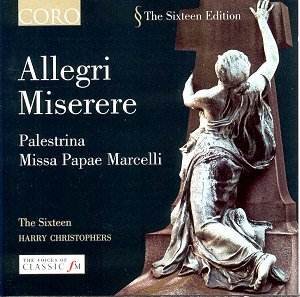Along with quite a few other discs from the Collins
Classics catalogue of the 1980s, this excellent disc makes a welcome
return to circulation at mid-price. It is not particularly generous
in terms of playing time and comes up against pretty stiff competition
in all the pieces. But from the opening bars of Lotti’s glorious
Crucifixus, it is evident that this is a choir and conductor
who know their business. The Sixteen’s work has now become fairly
well known and widely appreciated, but this disc did a lot to
consolidate their reputation in sacred choral music of the Renaissance
and beyond.
In the two most famous works on the disc, Allegri’s
Miserere and the Palestrina Mass, I found comparison
with The Tallis Scholars (Gimell), a long time favourite of mine,
to be quite illuminating. As a generalisation one might say that
what The Sixteen’s performance lacks in awe or mystery is more
than made up for in sheer ecstasy and fervour. Those famous tumbling
high Cs in the Allegri are piercing in their exaltation, where
in the Tallis Scholars performance they float out of the stratosphere
as if from God Himself. Both approaches are valid, in fact complementary,
and The Sixteen’s tonal splendour and vocal blend are a joy throughout.
The harmonic richness of the Palestrina Mass is fully conveyed,
and where Peter Philips may be more spacious and allow the polyphonic
lines to overlap completely naturally, Christophers’ slightly
brisker tempo does have its own rewards. The Sanctus, for example,
has a full-throated passion and intensity that is exhilarating,
and Palestrina’s forward-looking harmonic probing is brought fully
into the open.
Lotti’s tiny Crucifixus, which moved Dr.Burney
to tears in 1770, conveys a whole world of suffering in its 3-minute
span and is a gem of the choral repertoire. Once again The Sixteen
get a move on, the forward impulse and lack of dawdling or indulgence
helping to heighten the intensity and atmosphere. Lotti had learned
much from studying the polyphonic mastery of Palestrina, and the
latter’s gorgeous Stabat Mater also gets a rendition of
great intelligence and variety.
The whole programme is a delight, helped enormously
by the richly reverberant acoustic, warm and spacious without
any clouding of detail. The engineers do them proud, and Ivan
Moody’s brief but scholarly note is very helpful. Recommended.
Tony Haywood
